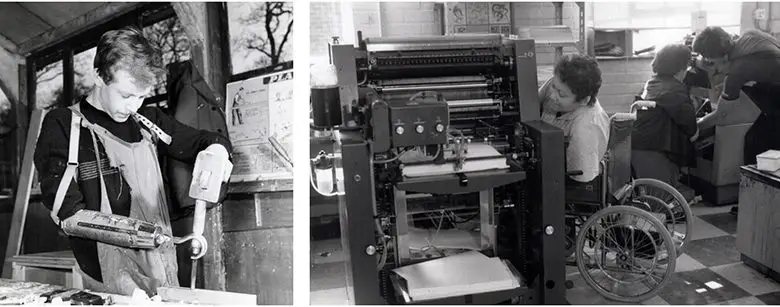
Crippled, Handicapped, Disabled: Living Beyond Labels
Crippled, Handicapped, Disabled: Living Beyond Labels is an exciting new exhibition that explores changing attitudes towards disability over the last eighty years. Held by Queen Elizabeth’s Foundation for Disabled People (QEF), a national charity that provides support and lifestyle solutions for disabled children and adults, the exhibition looks at eight themes: language, training, mobility, relaxing, working, living, reminiscing, and creativity.
The exhibition is at gallery@oxo, Oxo Tower, London from 20 – 24 April 2016 and is open daily 11am – 6pm and admission is free. Read on to learn more about the background behind the exhibition, and how society’s perception of disability has changed over the years.
How much has perception of disabled people changed since the 1930s?
Changing language and labelling disabled people is a key theme of the exhibition. When the charity was first founded in 1935 it was called The Cripples’ Training College. The way society talks about and treats disabled people has changed a staggering amount over the last eighty years, primarily because after the two World Wars the increase of disabled people in the UK had multiplied, and society recognised the need for change.
This included helping disabled people find employment through specialist training and sheltered workshops, and providing forms of transport, such as the three-wheeled Invacar. There was also a general sense that disabled people should now be integrated into society, where they had been previously kept apart.
The exhibition
To put together the exhibition QEF has been unearthing and digitising an archive of photographs, documents, and film, and sharing these with the public. It’s also been recording oral histories from past beneficiaries, working with a group of disabled actors to take a performance about disability to local schools, and creating a travelling version of the exhibition, which will tour around local towns. The overall aim of the project is to educate the general public about disability history, a field that has been underexplored and is often overlooked.
On show at the exhibition
At the exhibition there will be a range of text panels using newly digitised photographs and objects that will cover the eight aforementioned themes. For example, QEF is exhibiting a real iron lung, as it has archive photographs and film footage of taking a man in an iron lung on his first seaside holiday.
The exhibition will also display a range of hand-painted tiles from when one of its services was a sheltered workshop for disabled people. These tiles are beautifully crafted and painted, but embody a time when disabled people were segregated and hidden away. Now legislation and attitudes have changed to integrate people with disabilities into standard workplaces, however it could be argued we still have some way to go in this area. There will also be a life-size Invacar at the exhibition.
[masterslider id=”7″]At the exhibition you’ll be able to listen to newly recorded oral histories from past QEF beneficiaries via a converted 1950s telephone. Visitors will be able to dial a number to listen to short clips from a range of people that attended QEF’s training college and worked at QEF at pivotal moments.This includes a couple who met at the training college who speak about the shock of becoming disabled after their road traffic accidents, and a man who had been institutionalised after spending all of his childhood and teenage years in hospital before training at the college.
Most disability history sources come from a ‘top-down’ approach, meaning that the voices of disabled people themselves are rarely heard over the institutions that spoke for them. By recording and sharing oral histories from disabled people themselves, this provides academics and the public with a much deeper understanding of what life was actually like for disabled people.
Sharing history and changing attitudes
QEF is hoping that the exhibition will provide a new insight into recent disability history, showing what was life was like for disabled people who came through its services over the last eighty years. The exhibition also touches on how wider changes, events, and legislation have affected disabled people in this time period, such as World War Two and the Disability and Discrimination Act (1995).
QEF also hopes that the exhibition may help to change people’s attitudes towards people with disabilities even today, by showing what disabled people can achieve through work, training, creativity and daily life.
Crippled, handicapped, disabled: living beyond labels
When: 20 – 24 April 2016
Time: 11am – 6pm daily
Location: Oxo Tower Wharf, Bargehouse Street, South Bank, London, SE1 9PH
Admission: Free
For more information about the exhibition please go to www.oxotower.co.uk/events/crippled-handicapped-disabled-living-beyond-labels/ and to learn more about QEF please go to www.qef.org.uk
By Queen Elizabeth’s Foundation for Disabled People